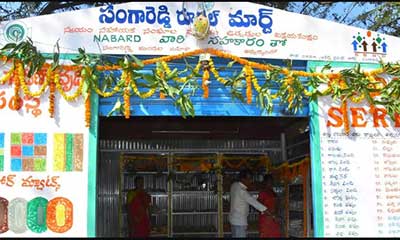Date: 20/04/2023
Relevance: GS-3: Indian Economy and issues relating to planning, mobilization, of resources, growth, development and employment.
Key Phrases: Rural Entrepreneurs, National Rural Livelihoods Mission, Mudra Yojana, Make In India, Self-Employment, Rural Self Employment And Training Institutes, Deen Dayal Antyodaya Yojana, One District One Product.
Context:
- There is immense scope for rural entrepreneurship in areas such as business, industry, and agriculture and this can help drive development.
Key Highlights
- Rural entrepreneurship has the potential to drive development in various sectors like agriculture, business, and industry.
- The Indian government has launched various flagship programmes such as National Rural Livelihoods Mission (NRLM), Make in India, Skill India, Startup India, and Mudra Yojana to promote and support rural entrepreneurship.
- These schemes provide financial assistance, training, and market
linkages to rural entrepreneurs.
- Despite these initiatives, rural entrepreneurship still faces several challenges.
Flagship Programmes Supporting Rural Entrepreneurship
- NRLM and DDU-GKY: The NRLM programme launched in 2011 has
provided access to finance, training, and market linkages to millions of
rural entrepreneurs.
- NRLM has played a crucial role in establishing India’s large network of Self Help Groups (SHGs), which enables individuals to organize themselves into small groups to save and borrow money while promoting self-employment and entrepreneurship.
- Under NRLM, Deen Dayal Upadhyaya Grameen Kaushalya Yojana (DDU-GKY) is a structured programme that links skill development with placement in a Public-Private Partnership (PPP) mode for rural youth.
- RSETI: Another promising initiative is the Rural Self Employment and
Training Institutes (RSETI) programme which promotes entrepreneurship.
- Launched in 2013, it aims to provide skill-building and facilitate micro-enterprise development of community members, leading to better employment and entrepreneurship outcomes.
- Startup India: The Startup India initiative, launched in 2016,
aims to promote entrepreneurship among the youth of India.
- It provides a range of incentives to startups and entrepreneurs, including easier patent registration, tax credits, and free mentorship programmes.
- DDAY: Deen Dayal Antyodaya Yojana (DDAY), launched in 2014, is a
similar initiative aimed at providing financial assistance, training, and
market linkages to rural entrepreneurs.
- The scheme focuses on sustainable livelihoods for the rural poor, through a range of interventions to address both the demand and supply-side hurdles in promoting livelihoods.
- ODOP: Additionally, the One District One Product (ODOP) scheme
identifies products unique to particular districts and promotes their
production and marketing.
- The initiative provides a platform to local entrepreneurs to promote their products and enables job creation by harnessing local resources.
Challenges Faced by Rural Entrepreneurship
- Despite the existence of several flagship programmes, rural
entrepreneurship continues to face several challenges.
- Limited access to finance, inadequate infrastructure, and a lack of training and education pose the most significant obstacles.
- According to the Periodic Labour Force Survey (PLFS) 2020-21, the share of self-employed workers in rural areas is 61.3 per cent compared to 39.5 per cent in urban areas.
- Although the share of self-employed workers in rural areas is higher than in urban areas, most of them (43.48 percent) are own-account workers who operate in small-sized, family-based, own-account units with low investment and technical knowledge.
- Rather than providing employment, rural entrepreneurship
continues to serve as a means of subsistence/existence. The majority of
self-employed individuals are Own account employees, not employers.
- PLFS 2020-21 also reveals that only 12% of self-employed individuals sell their entire output. Approximately 13% of self-employed individuals consume the entirety of their own output.
The Way Ahead
- To address these challenges, a holistic approach that combines
policy support, infrastructure development, and capacity building for rural
youth entrepreneurs is needed.
- Support for promoting indigenous/hereditary skills is also required to scale up operations.
- Moreover, there is a need to provide vocational/technical training
to rural entrepreneurs.
- For instance 69.73 per cent of workers out of total rural manufacturing workers have not received any training, which indicates the need for comprehensive training programs.
- Finally, partnering with private entities, NGOs, and other stakeholders in shaping potential entrepreneurs’ business models, marketing strategy and product development could help ensure rural entrepreneurship success.
Conclusion
- Rural entrepreneurship has the potential to drive development in
various sectors such as agriculture, industry, and business.
- With government and private-sector support, rural entrepreneurship can create employment opportunities, reduce poverty, empower women, and drive innovation in rural areas.
- There is a need to provide access to finance, infrastructure development, comprehensive training programs, and supportive policy to unleash the full potential of rural entrepreneurship.
- Rural entrepreneurship must be approached comprehensively, and all stakeholders must work together to provide access, resources, and training for rural entrepreneurs to succeed.
Source: The Hindu BL
Mains Question:
Q. "Discuss the challenges faced by rural youth entrepreneurs in scaling up their ventures and suggest a holistic approach that combines policy support, infrastructure development, capacity building, and promotion of indigenous skills to enhance their productivity." (250 words).








